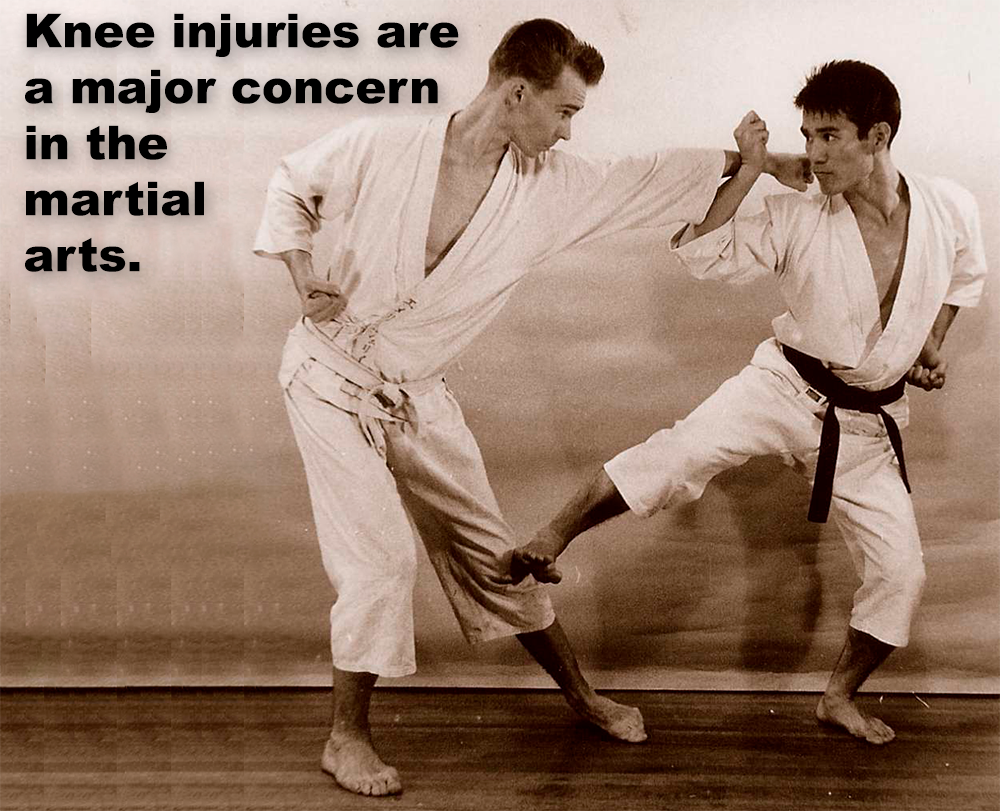
The knee is the largest joint of the body, and is vulnerable to a variety of injuries. Since it is a complex joint, care must be taken to evaluate any knee injury.
.
In martial arts, and many other athletic endeavors, injuries can be devastating. Knee injuries are the leading cause of long term disability in athletes.
.
The best prevention for knee injuries is: 1) proper conditioning of the muscles of the legs, 2) common sense in training, and 3) an understanding of the mechanics of the knee.
.
The three bones that make up the knee are the femur (thigh), the tibia (calf) and the patella (knee cap). Ligaments are dense, fibrous bands of tissue that connect the bones and provide stability. They do NOT stretch, but under enough tension will tear or rupture. The two major ligaments that provide side to side stability are the medial and lateral collateral ligaments.
.
The medial (means middle or inner) meniscus and the lateral (outer) meniscus sits between the femur and the tibia and act as cushioning devices.
.
The real stabilizing structures are the anterior (one in front) and the posterior (the one in the back) cruciate ligaments. They are so named because the cross each other in the center of the knee joint. They are VERY important. They provide stability to the knee joint so it does not rotate in a circle, and over extend.
.
Lastly, the muscles surrounding the knee joint provide more stability, but more importantly the energy and force for the joint to move. One must remember: the knee joint’s primary movement or axis is in one direction only! The knee flexes and extends. It does not rotate in a circle like the hip. Any deviation to this principle will cause an injury.
.
The most benign and simplest injuries to the knee are caused by overuse. They include tendonitis, especially the patellar tendon and/or the hamstrings from over-extending a front kick. Rest, ice, anti-inflammatory medication (like ibuprofen) and sometimes physical therapy and immobilization with a brace are needed. Proper conditioning of the quadriceps and hamstrings are needed before return to full activity to prevent further injury.
.
Another possible injury is a dislocation of the patella, or knee cap. You may hear a “pop”, and the person will have pain, and an inability to stand. Upon visual observation, you will notice that the patella is pointing sideways on the knee. Don’t delay, get the person to an ER. Again, with proper treatment and conditioning, one may return to training after healing.
.
More serious injuries include: ACL (anterior cruciate ligament) tears, MCL (medial collateral ligament) tears, PCL (posterior cruciate ligament tears) and torn cartilage (medial or lateral meniscus tears.
.
ACL tears can occur when changing direction rapidly, or keeping the foot planted and rotating the body around the fixed foot. These are serious and require proper evaluation by an orthopedic specialist, and may require surgery and rehabilitation.
.
PCL tears may be caused by a direct blow to the front of the knee. Again, this is a serious injury and requires immediate attention and a break from training until evaluation, treatment, and rehabilitation are complete.
.
MCL tears are caused by a direct blow to the side of the knee. An example is in sparring when the lead knee is accidentally kicked by your opponent.
.
A tear in the cartilage (meniscus) occurs when twisting (can be while stepping, kicking, or landing), changing directions quickly, and pivoting. Direct contact is often involved. Swelling and clicking or locking of the knee joint is common symptoms. Proper medical evaluation, possibly an MRI, and arthroscopic surgery may be needed. These should not be ignored, as they can cause progressive destruction of the joint which in later years will require a joint replacement surgery.
.
In conclusion, the most important advice is to seek treatment as soon as possible if you:
.
1) Hear a popping noise and feel your knee give out
2) Have severe pain
3) Cannot move the knee
4) Begin limping
5) Have swelling and or discoloration at the injury site
.
The best prevention is to train wisely both inside and outside the dojo. Strengthen the knee joint with strength training, stretch properly and often, and understand your limits for your rank, your body type, and your age.
.
With thanks to Dr. Vincent J. Muscarella DPM
.
.
.
The information on this page is not intended or implied to be a substitute for professional medical advice, diagnosis or treatment. All content, including text, graphics, images and information, contained on or available through this page is for general information purposes only. NEVER DISREGARD PROFESSIONAL MEDICAL ADVICE OR DELAY SEEKING MEDICAL TREATMENT BECAUSE OF SOMETHING YOU HAVE READ ON OR ACCESSED THROUGH THIS PAGE.
